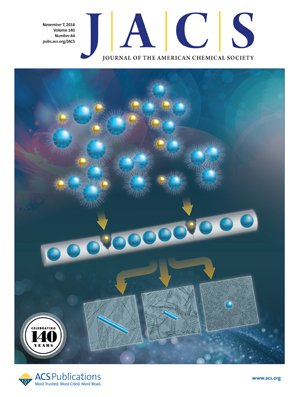Journal of the American Chemical Society 09/2018; 140(44)
Benjamin W. SteinJing YangRegina MteiNicholas J. WiebelhausDominic K. KersiJesse LePluartDennis L. LichtenbergerJohn H. Enemark*Martin L. Kirk*

Abstract: A multitechnique spectroscopic and theoretical study of the Cp2M(benzenedithiolato) (M = Ti, V, Mo; Cp = η5-C5H5) series provides deep insight into dithiolene electronic structure contributions to electron transfer reactivity and reduction potential modulation in pyranopterin molybdenum enzymes. This work explains the magnitude of the dithiolene folding distortion and the concomitant changes in metal-ligand covalency that are sensitive to electronic structure changes as a function of d-electron occupancy in the redox orbital. It is shown that the large fold angle differences correlate with covalency, and the fold angle distortion is due to a ps eudo-Jahn–Teller (PJT) effect. The PJT effect in these and related transition metal dithiolene systems arises from the small energy differences between metal and sulfur valence molecular orbitals, which uniquely poise these systems for dramatic geometric and electronic structure changes as the oxidation state changes. Herein, we have used a combination of resonance Raman, magnetic circular dichroism, electron paramagnetic resonance, and UV photoelectron spectroscopies to explore the electronic states involved in the vibronic coupling mechanism. Comparison between the UV photoelectron spectroscopy (UPS) of the d2 M = Mo complex and the resonance Raman spectra of the d1 M = V complex reveals the power of this combined spectroscopic approach. Here, we observe that the UPS spectrum of Cp2Mo(bdt) contains an intriguing vibronic progession that is dominated by a “missing-mode” that is composed of PJT-active distortions. We discuss the relationship of the PJT distortions to facile electron transfer in molybdenum enzymes.
eudo-Jahn–Teller (PJT) effect. The PJT effect in these and related transition metal dithiolene systems arises from the small energy differences between metal and sulfur valence molecular orbitals, which uniquely poise these systems for dramatic geometric and electronic structure changes as the oxidation state changes. Herein, we have used a combination of resonance Raman, magnetic circular dichroism, electron paramagnetic resonance, and UV photoelectron spectroscopies to explore the electronic states involved in the vibronic coupling mechanism. Comparison between the UV photoelectron spectroscopy (UPS) of the d2 M = Mo complex and the resonance Raman spectra of the d1 M = V complex reveals the power of this combined spectroscopic approach. Here, we observe that the UPS spectrum of Cp2Mo(bdt) contains an intriguing vibronic progession that is dominated by a “missing-mode” that is composed of PJT-active distortions. We discuss the relationship of the PJT distortions to facile electron transfer in molybdenum enzymes.
Available for purchase here.
